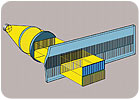
Sealed optical encoders are designed for harsh industrial environments; however, the casing can prove limiting with regard to friction. Source: Heidenhain Corp.
The optical encoder has two main parts: the optical graduation and the electronic eye, called the scanning unit or reader head. Optical encoders, in a sense, are transducers, converting a measured length or movement into a series of manageable electrical counts, each count representing a precise distance. In many cases, optical encoders are at the core of instrumentation used for length and dimensional measurements.

Optical encoders are comprised of an optical graduation and a scanning unit. Source Heidenhain Corp.
The Types
There are two general groups of optical encoders: exposed and sealed. Exposed optical encoders are frictionless, kit-style versions that require the customer to mount the scanning unit to a bracket, making it the customer’s responsibility to ensure that the scanning unit rides very close to the optical graduation. The optical graduation is typically mounted to the instrument or machine in the direction of measurement or particular motion. Even though these encoders can handle environmental contamination, such as fingerprints, dust and small amounts of liquid, they are sensitive to major contaminants, such as coolant, opaque oils, sawdust and heavy machine vibration.For harsh industrial environments, sealed optical encoders are available. As the name implies, these encoders protect their optical graduation and scanning unit with a robust casing. Sealed encoders also are built to withstand heavy vibrations and contain sealing lips to allow for the scanning unit to move back and forth without exposing the optical graduation to liquids. However, with the protection of the casing comes some limitation with regard to friction, as the scanning units ride on bearings to keep the scanning gap appropriate; there also is friction between the scanning unit and protective sealing lips. This friction, however, can be overcome in manual and controlled applications. In either group of optical encoder, the scanning unit or the graduation can be the moving element for measurement.

Frictionless, kit-style exposed optical encoders are for environments that do not present contamination hazards to the instrument. Source: Heidenhain Corp.
The Specifics
A notable feature of optical encoders is that a home pulse, or reference mark, can be placed on the optical graduation and detected by the scanning unit. Determining a home position before making length measurements is critical. Also, optical graduations-which can be from 200 microns per count to 512 nanometers per count in the raw state-have the possibility of unique positions, or absolute positions.Originally, encoder graduations contained lines that did not vary, so there were no distinguishing features from one count to the next. This style of graduation is called an incremental graduation.
Newer technology has allowed optical graduations with unique positions for every count along the length measurement. This is done by having the normal incremental track in conjunction with a separate track that is coded, similar to an extremely long barcode. The scanning unit can then read both tracks and calculate a unique position value for every count along the length of scale. This allows the machine to forego initial homing routines and also allows for greater machine safety in case of power failures. The scanning units of such encoders are electrically more complex than those of incremental graduation encoders because of the amount of information that needs to be transmitted to the controller, which requires a high-speed serial data interface.
Electrically speaking, scanning units output counts and each count represents a distance. Electrically multiplying these counts and subdividing them for more resolution is a common practice in industry. An analog count of 4 microns can be multiplied through digitization, or interpolated, from a simple one-time digitization to more than 4,000 times. This interpolation does not affect the accuracy of the total length of the optical graduation, but it can affect the accuracy within one count. This is called short wave error.
It is possible for an optical encoder to outperform a laser interferometer. There are optical graduations finer than the typical wavelengths of light emitted by laser interferometers. And because the graduation is fixed on a glass-type substrate, it is not susceptible to environmental fluctuations such as temperature and pressure. The small air gap between the reader head and the graduation allows for negligible environmental effects, which increase accuracy. These graduations only can be measured against true physical standards that are directly traceable to the National Institute of Standards and Technology (NIST) and Federal Physical and Technical Institute (PTB).
Optical linear encoders are suited for length measurement in either the laboratory or harsh industrial environments. When choosing instrumentation for length measurement, one must keep in mind what technology is at the core of the instrument, and evaluate whether its accuracy will satisfy the application.